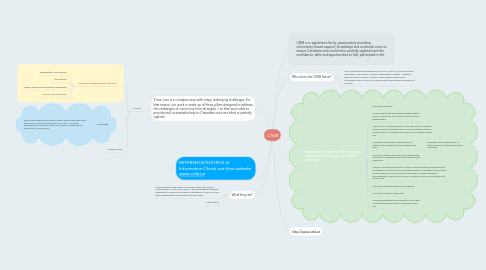CNIB
by Laura Jones


1. Vision loss is a complex issue with many underlying challenges. For that reason, our work is made up of three pillars designed to address the challenges of vision loss from all angles – so that we’re able to provide real, sustainable help to Canadians who are blind or partially sighted.
1.1. 3 Pillars
1.1.1. Community Based Support/ SERVICES
1.1.1.1. Rehabilitation and Support
1.1.1.2. CNIB Library
1.1.1.3. Helpful Products and Assistive Technology
1.1.1.4. CNIB in your community
1.1.2. Knowledge
1.1.2.1. World-class research focused on better serving and improving the quality of life for people with vision loss – studying everything from practical vision loss needs to rehabilitation outcomes to social policy.
1.1.3. National Voice
2. REFERENCE/SOURCE of Information:Check out their website www.cnib.ca
3. What they do?
3.1. specialists work with people of all ages in their own homes, communities or local CNIB offices – providing the personalized rehabilitation support they need to see beyond vision loss, build their independence and lead the lives they want.
3.2. Destinations
4. CNIB is a registered charity, passionately providing community-based support, knowledge and a national voice to ensure Canadians who are blind or partially sighted have the confidence, skills and opportunities to fully participate in life.
5. Who does the CNIB Serve?
5.1. Any Canadian who has experienced a loss of vision, in any community nationwide, can come to CNIB for rehabilitation support – whether you’re an adult or senior; a child or teen; whether you’ve been completely blind all your life or have recently experienced a partial loss of vision.
6. How does the agency address equity, inclusion and awareness of cultural diversity?
6.1. Advocacy Initiatives
6.2. CNIB believes that all children have the right to literacy instruction and to be as literate as their sighted peers
6.3. The CNIB is a Canadian voice for the education of students who are blind or living with vision loss A Canadian voice for the education of students who are blind or living with vision loss.
6.4. Preschool children have equal access to appropriate emergent literacy materials and skills.
6.4.1. Emphasis on the importance of braille literacy for those who would use braille
6.5. Access to literacy instruction for students who are blind or living with vision loss with additional disabilities
6.5.1. Destinations
6.6. Literacy instruction programs for (school-aged) children and youth must be designed and delivered by qualified teachers of students who are blind or living with vision loss. Families of preschool children should be encouraged to involve their children in programs that promote literacy at an early age
6.6.1. Destinations
